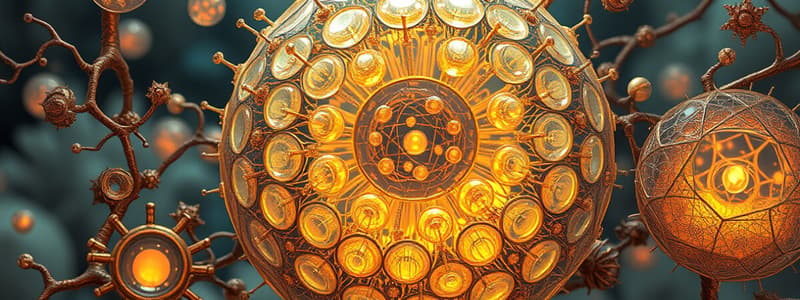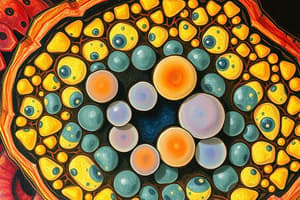Podcast
Questions and Answers
Which of the following is an organelle that controls the cell and tells it what to do?
Which of the following is an organelle that controls the cell and tells it what to do?
- Mitochondria
- Vacuole
- Nucleus (correct)
- Ribosome
Which organelle is known as the 'powerhouse' of the cell?
Which organelle is known as the 'powerhouse' of the cell?
- Lysosome
- Chloroplast
- Nucleus
- Mitochondria (correct)
Which organelle is involved in protein synthesis?
Which organelle is involved in protein synthesis?
- Golgi Apparatus
- Ribosome
- Both A and C (correct)
- Endoplasmic reticulum
What is the function of lysosomes?
What is the function of lysosomes?
Describe the function of vacuoles.
Describe the function of vacuoles.
What is the primary function of chloroplasts?
What is the primary function of chloroplasts?
What protects the cell from its surroundings?
What protects the cell from its surroundings?
The _____ is a semi-permeable layer outside the plant cell, fungi, algae, and bacteria.
The _____ is a semi-permeable layer outside the plant cell, fungi, algae, and bacteria.
What is the main component of the cytoplasm?
What is the main component of the cytoplasm?
What cellular process takes place in the cytoplasm?
What cellular process takes place in the cytoplasm?
What role do centrioles play during cell division?
What role do centrioles play during cell division?
Flashcards
Nucleus
Nucleus
Controls cell activities and stores genetic information (DNA).
Lysosome
Lysosome
Contains digestive enzymes for breaking down waste materials and cellular debris.
Centriole
Centriole
Involved in cell division, specifically in organizing spindle fibers.
Cytoplasm
Cytoplasm
Signup and view all the flashcards
Cell membrane
Cell membrane
Signup and view all the flashcards
Mitochondria
Mitochondria
Signup and view all the flashcards
Vacuole
Vacuole
Signup and view all the flashcards
Chloroplast
Chloroplast
Signup and view all the flashcards
Golgi apparatus
Golgi apparatus
Signup and view all the flashcards
Endoplasmic reticulum
Endoplasmic reticulum
Signup and view all the flashcards
Cell wall
Cell wall
Signup and view all the flashcards
Study Notes
Organelles Identification
- Nucleus: Controls cell activities and genetic information.
- Lysosome: Contains digestive enzymes for waste breakdown.
- Centriole: Involved in cell division, aids in spindle fiber formation.
- Cytoplasm: Semi-fluid medium for cellular processes, facilitates metabolism.
- Cell membrane: Protective lipid bilayer, regulates substance exchange.
- Mitochondria: Known as the "powerhouse" of the cell, generates energy.
Plant Cell Organelles
- Vacuole: Storage structure for fluids, food, and waste materials.
- Chloroplast: Site of photosynthesis, converts sunlight into chemical energy (ATP, NADPH).
- Cell membrane: Similar function as in animal cells, protects and facilitates transport.
- Golgi apparatus: Modifies, sorts, and packages proteins from the endoplasmic reticulum.
- Endoplasmic reticulum: Synthesizes proteins and lipids, has rough (with ribosomes) and smooth (without ribosomes) regions.
- Cell wall: Provides structure and support in plants, fungi, and some bacteria.
Functions of Key Organelles
- Nucleus: Regulates cellular functions, stores DNA.
- Ribosome: Synthesizes proteins from messenger RNA.
- Endoplasmic reticulum: Processes and transports proteins and lipids.
- Golgi apparatus: An integral hub for protein modification and delivery.
Additional Functions
- Vacuoles: Maintain osmotic balance and store essential compounds.
- Lysosomes: Digest cellular debris and foreign invaders.
- Mitochondria: Break down nutrients to produce adenosine triphosphate (ATP).
- Cell membrane: Determines cell's permeability and communication with the environment.
More Organelles Insights
- Cytoplasm: Site for glycolysis and general metabolic activities, contains dissolved macromolecules.
- Chloroplasts: Contains chlorophyll for photosynthesis, crucial for plant energy conversion.
- Cell wall: Offers rigidity and defense against mechanical stress and pathogen invasion.
- Centrioles: Organize microtubules during cell division, critical for proper chromosome segregation.
Studying That Suits You
Use AI to generate personalized quizzes and flashcards to suit your learning preferences.




